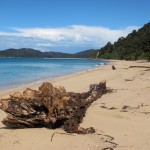
We were just one hour into our hike along the famed Abel Tasman Coastal Track, one of the nine great walks of New Zealand. And it was tea time.
We were familiar with many of the great walks, the Milford with its moderate but lengthy hiking and one killer day, the Routeburn with several steep ascents and descents plus a long swooping ridge along the mountains, the day-long Tongariro Crossing with its breath-challenging climb up to the volcano mouth and seemingly endless descent, and the Queen Charlotte with days of hiking up and down the hills of Marlborough Sounds. At each of these guided hikes, you could set your own pace so that you typically only met up with a group at the end of the day. Nancy recalls an 80-plus year old married couple at the Milford that always arrived last, but finished happily.
Things were clearly very different here on the Abel Tasman. The small group we found ourselves with had booked the five day excursion, with hiking on the odd days and other activities on the even days. Those options included light kayaking or walking around two estuaries where the lodges were located. We had chosen to kayak instead of hike on the third and fifth day, and were very glad we did. For we discovered that this track was really a walking trail, which could have been completely covered by a reasonably fit walker in just two days – with plenty of time for sightseeing. To make matters worse, the group was held close together by the guides so different levels of walkers kept meeting up for long breaks during the day.
Now we hardly ever stop during a hike except sometimes for a picnic lunch when we expect to be trekking for five or six hours, or to down some water, or – most likely – to observe birds or admire spectacular views. And we don’t serve tea. The guides seemed to think we would all expire if it were not for regular treatment with the restorative powers of tea and snacks. And the silliest of these breaks was the first day’s, after just one hour on an easy-going hill, with but a half hour left to cover in the day. True, the beach on which we stopped was beautiful, but so were the innumerable series of smooth sand beaches all along the track.
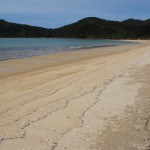
Despite the disappointments, however, the trip was not a disaster for we made the most of our situation.

As to hiking, on day two, we set off on our own to scale the short skyline ridge out of Awaroa Bay for a couple of hours, after a pleasant guided walk along the estuary at low tide (including, of course, a tea break). The estuaries truly are worth seeing: to cross at high tide, you would have to swim or boat through what has become a surprisingly deep bay; at low tide, you can easily walk across the golden expanse where wet sand and shallow streams interweave beautifully in the sun.
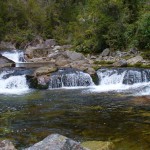
The next day, before our kayaking, we pushed ahead of the group on the 1-2 hour walk to our launch point on day three, keeping a much more vigorous pace. The fourth day at Torrent Bay, again on our own, we did a challenging 1000-foot climb on much rougher track to Cascade Falls and the pools above it, home of the 60 year old eel. That made for a very appealing four hours or so.

Nonetheless, if we had chosen to walk on days three and five, we would have been pretty disappointed. Instead we enjoyed the physical and mental challenge of ocean kayaking – as well as the challenge for the two of us occasionally of coordinating ourselves.

We got our feet wet, so to speak, on day three with about four hours on mostly benign waters. The main work was paddling against windy conditions rounding a rocky islet colonized by NZ fur seals and adorned with pied and spotted shags.
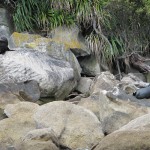
Otherwise, we got a strenuous upper body workout while enjoying splendid views of sandy coves and granite caves, visible only by those who cross on water. And we heard a number of stories of the people who lived in these isolated stretches, staving off madness and solitude.
From the start on day five, we had to deal with much stronger winds and deeper waves. Brewing up all morning was – no not tea – but a storm front, clearly visible out to sea. The winds drove up waves of a meter or so – as well as our adrenalin. Most of the waves pushed us forward, but around the headlands and even within the bays, they shifted continuously, one moment from the windy left, one moment from the right, the next head on. We felt a bit, well, at sea.
When in trouble, paddle harder, our guide had said. So that is what we did, particularly in the hour long crossing of huge Sandy Bay, a passage dubbed the “mad mile” by kayakers. Our neighbors here in Wellington told us they often had rescued upended kayakers in that section, so we were mentally on high alert. Fortunately, the conditions weren’t quite so tough as we thought, or perhaps we paddled hard and well enough. Oddly, around the middle of the mad mile, our guide asked us whether we had experience kayaking in rough ocean conditions. That kept us pondering while we bravely paddled. Were we doing a good job of it? Were we so bad that he couldn’t believe we had prior experience? Or was he alerting us to even worse conditions to come? We both chose the first option, which seemed a lot more calming.
We survived without a dunking, and found it all worth the effort. In the first broad bay, for example, dozens of Australian gannets arced overhead, then dive-bombed the ocean surface to catch their prey. Aerodynamic terns mimicked them. Ducks and shags paddled by. A few petrels shot across our bow toward deep water. The rocky shoals at each headland showed off more preening shags and gulls. These things we could not have enjoyed by taking the walking track, even on a tea break.
And there were other sights. We bobbed around several caves, some of which could be kayaked when the tide was higher. The largest of these was already dried up when we arrived after passing rocks encrusted with myriad mussels. Instead, we walked through the cave until it was too dark to see (Ah, is that a rock wall in front of my face?), then squeezed through the adjacent granite archways. We marveled at the vivid purple rivulets that appeared to bleed through the auburn sand and trickle seaward, some alloy of different metals including chromium and magnetic iron.
Along the shores of the secluded bays, granite rocks formed into recognizable images – the giant kiwi drinking from the ocean, the 3 meter tall golden eagle with a sandy head and charcoal body, the three rock Mickey Mouse embedded in the trees on another islet, and the split rock.
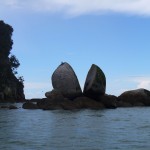
That last one, just before the end of our day, came with an interesting native story. The Maori creation myths typically revolve around some overthrow of the mother and father gods by their sons which caused the world to divide into light and dark, sea and land, and so on. The legend surrounding the split rock was that it originally was an egg coveted by the two sons, the land ruler and the sea ruler. They shared this egg equally: at low tide, it nested high and dry on rocks and connected to the land; at high tide, it floated on the sea. The sons fell to squabbling over the egg and one threw a spear that missed the other and split the egg, spoiling it for both of them by turning it into a useless split rock.
A lesson for the next generation of the danger of fighting, not peace? A way of noting the dramatic tidal change that turns sandy stretches into deep bays and back again? Or perhaps, for us, a reminder that you can often stir good things from a bad situation, turning a broken egg into an omelet.
(For more pictures from New Zealand, CLICK HERE to view the slideshow at the end of the New Zealand itinerary page.)



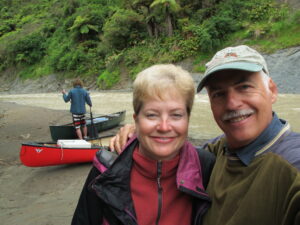
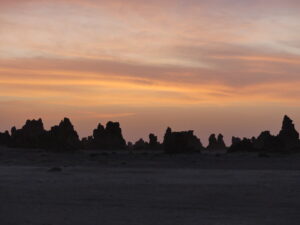
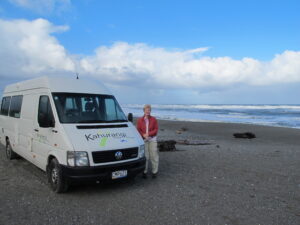
How does one know an eel’s age? Is there a sign? Also: have you heard of the bad joke eel?
I know that you are not supposed to ask an eel it’s age. Very poor decorum on the trail.
http://www.quickmeme.com/Bad-Joke-Eel/
Ay, ay, ay…those are pretty good bad jokes from an eel.